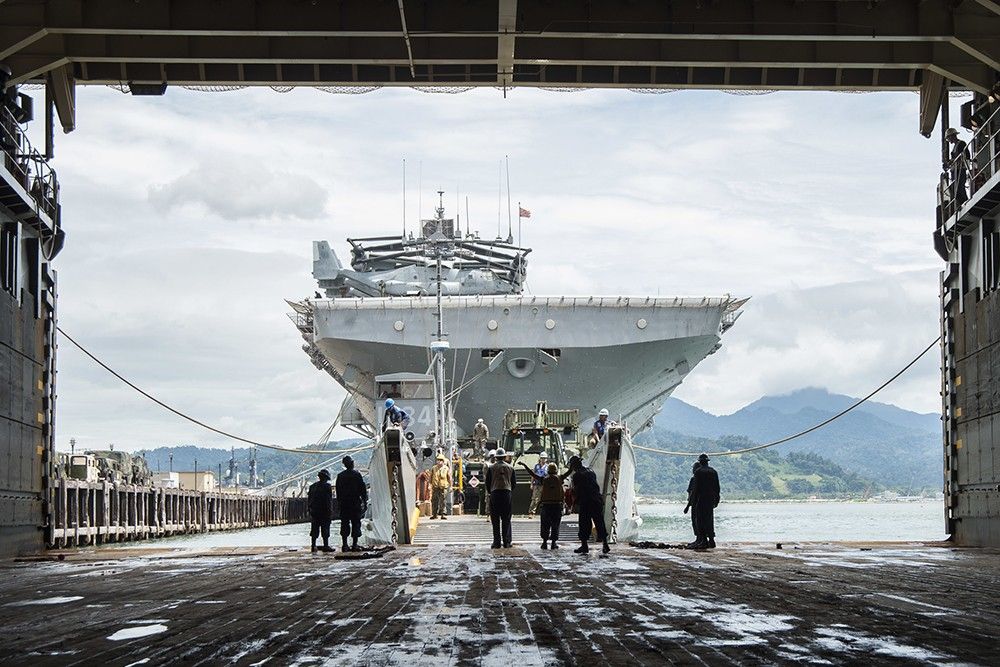Analysis: Gambling with trust in the Philippines-US military alliance

For most years since independence, the Philippines has not faced a serious armed threat from another country. The quiet has been explained as the result of many things: the disinterest of major powers, the goodwill fostered by ASEAN, and the focus of Southeast Asian governments on domestic needs, as chief among them. In the middle of these dynamics is the Philippines-United States (US) alliance, which in 2016 marks its 65th year. Despite its longevity, the relationship has been fraught with periods of distrust.
Today, President Rodrigo Duterte appears set to change the future of the Philippines’ defense relationship, and possibly at any cost.
The Philippines-US alliance
The American colonization of the Philippines meant that US forces had been on the archipelago for almost the entire 20th century. After the Philippines obtained independence in 1946, its new sovereign government signed a Mutual Defense Treaty with the US on Aug. 30, 1951. The treaty established a new foundation for Philippine-American defense relations, setting out an objective of collective defense, such that “no potential aggressor could be under the illusion that either [country] stands alone in the Pacific area.”
Part of the Philippine reasoning for the alliance had been the country’s lack of an independent and effective armed forces for most of its history. The Philippine Army, as we know it today, had only been established by law in 1935; the Navy in 1940.
Part of the Philippine reasoning for the alliance had been the country’s lack of an independent and effective armed forces for most of its history.
Immediately after the war, the Philippine military as an institution was close to infancy. At the time, it made sense for the government to let the military focus on domestic threats, which formed the bulk of the country’s concerns, and to have the US guarantee against external attack. On the part of the US, its military kept its first and main foothold in Southeast Asia. (In 1954, Thailand became a US treaty ally upon joining the now-defunct SEATO; In 1990, Singapore allowed the US to access its military facilities.)
In the period since, the Philippines-US military relationship has gone through several phases and ups and downs. Notable events include the landmark Senate decision to close US bases in the Philippines in 1991, the Visiting Forces Agreement (VFA) of 1998, and the Enhanced Defense Cooperation Agreement (EDCA) of 2014.
The Philippines-US military relationship has gone through several phases and ups and downs.
Many will also remember that the Philippines had sent a small, 43-person humanitarian contingent to Iraq in 2003, withdrawing it as a condition for the release of hostage Angelo Dela Cruz; those with longer memories may recall that the country also sent a 1000-troop Civic Action Group to Vietnam from 1966-1969.
Alarm bells in Manila
The Philippines-US relationship has seen new interest because of China’s increased activity, called “assertive” or “aggressive,” in the South China Sea. The PRC was a relative late-comer to the regional rush to occupy islands in the South China Sea, but well before 2000 the country had not only held a variety of reefs, it had begun to build what it called fishermen’s outposts on those reefs.
Although the Philippine government had protested at the time, the alarm bells did not ring too loud until over a decade later: during the 2012 Philippines-China stand off at Scarborough Shoal, and after China began fast-spaced, large-scale construction atop several reefs in 2014.
Today, the perceived of external threat to the Philippines has changed. Although small minority see full-blown war on the cards, to most the threat is a creeping encroachment, symbolized by Scarborough Shoal, that prevents the Philippines from fully exploiting its Exclusive Economic Zone (EEZ) and, as part of that, prevents Filipino fishermen from pursuing their traditional livelihoods. Beyond the Philippines and its EEZ, the activities of China’s ‘maritime militia’ are known to operate throughout the South China Sea.
Today, the perceived of external threat to the Philippines has changed.
Under Duterte’s watch, the Philippines has kept quiet on the July ruling from the Arbitral Tribunal on the case that the Philippines had lodged against China. This quiet led the way for previously vocal international support to die down. Although Duterte has said that any agreement with China will not go beyond “the four corners” of the ruling, it remains to be seen how this will come about as China has insisted that the ruling has no validity.
Revitalized alliance?
Having focused on its internal security mandate, by 2012 the Philippine military had not been able to fully monitor, prevent, or defend against encroachment, let alone a threat to the whole of the archipelago. Although forced to consider the country’s options, many probed the US commitment asking - Would the Americans really come to our defense? Would the US help enforce the Tribunal’s ruling? Is there a red line?
American officials, all the way up to US Defense Secretary Ash Carter and US President Barack Obama, have called their commitment to the Philippines “ironclad,” but also stopped short of defining it. To some Filipinos, that ambiguity is a yawning loophole. To some Americans, excessive clarity could send the wrong message both to the Philippines (that in its zeal could ‘drag’ the United States into an unnecessary conflict) and to China (that in knowing where the line was, could keep its activity just below the ‘trigger’ point). Without knowing what was discussed in private, the Filipino desire for clarity and the American desire for ambiguity nevertheless hinted at a limit to the supposed trust of friends and partners.
American officials have called their commitment to the Philippines “ironclad,” but also stopped short of defining it.
In characteristic fashion, Duterte has changed the game by affirming that mistrust. There are no assumptions to be had about the future of the Philippine relationship with the United States, with China, or with any other power. On one hand, there have always been pros and cons to being associated with the United States—although many felt that for negotiating over the West Philippine Sea, the pros outweighed the cons. On the other hand, being less associated with the US does not mean the AFP will become a more credible independent force. At its root, however, the recent about-face on the alliance reflects a lack of inter-governmental trust.
There have always been pros and cons to being associated with the United States—although many felt that for negotiating over the West Philippine Sea, the pros outweighed the cons.
Gauging reliability by working side by side
Leaving aside officials’ statements, there are other ways of gauging the reliability of your treaty partner, not only over the disputes in the South China, but over a longer period and over a wider range of challenges. One way to gauge is by looking at their behavior in peacetime, to see if they are preparing with you to work together if the need arises. The Mutual Defense Treaty itself gives some guidance, specifically Article II: “In order more effectively to achieve the objective of this Treaty, the Parties separately and jointly by self-help and mutual aid will maintain and develop their individual and collective capacity to resist armed attack.”
The value of equipment transfers from the US in support of the modernization process of the Armed Forces of the Philippines are one way for the US to signal its commitment. Over the past 15 years, the US effectively waived 70 percent of the costs to the Philippines in government-to-government arms sales. This is separate from the Excess Defense Articles program, through which the Philippine Navy has received three refurbished warships in the last five years. Through the same program, the country received one of two C-130 planes promised (bringing the national total now to 5) just on Monday.
The value of equipment transfers from the US in support of the modernization process of the Armed Forces of the Philippines are one way for the US to signal its commitment.
More than hardware, however, is the effort that the two countries’ militaries put into ensuring that their troops can believably work side by side or shoulder to shoulder (Balikatan). Ultimately, the less that militaries practice working together, the less believable it is that they actually will.
This concept is sometimes distilled into terms like interoperability (the compatibility of equipment and procedures) and camaraderie (relations between troops), but the underlying principle is the same. By going through joint exercises and launching dialogues, both countries put in time and money toward their commitment, and in return develop their skills to work alone and to work together. These are the signs that make the treaty commitment more than a piece of paper.
By going through joint exercises and launching dialogues, both countries put in time and money toward their commitment, and in return develop their skills to work alone and to work together.
There are limits to the training exercises that the Philippines and the US can hold together. Because you can only practice military capabilities that you already have and for contingencies that you are interested in, there are natural constraints to what the two militaries can do together. The benefits specific to each country depend on the specific exercise: the US has gained from working with Philippine troops experienced in counter-insurgency operations and jungle survival, the Philippines can benefit from naval drills, and both countries benefit from a more capable alliance they can trust.
Removing military exercises and ending defense cooperation lends no obvious gain to the Philippines. Despite the country’s colonized past, military exercises since independence had reflected decisions made by both countries toward shared security. In this light, defense cooperation should be understood not only as a symbol of a different time, but as a practical effort that can grow in value as the Philippine military comes into its own.
Removing military exercises and ending defense cooperation lends no obvious gain to the Philippines.
Duterte has changed the focus of our defense policy, making it simultaneously more inward—oriented against internal security—and less able to depend on international partners over the long run. In exchange, the administration may hope to gain concessions from China. It is an interesting new path for the Philippines, and Filipinos should hope that this gamble pays off.
***
Angelica Mangahas is the deputy executive director of Stratbase-Albert Del Rosario Institute (ADRi).
- Latest
- Trending


























